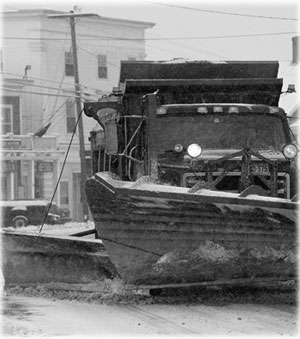
Vol. 75, No. 11, November
2002
Proximate Cause and Municipal Liability
Broken Windshields and Busted Mailboxes: Municipal Liability for Motor
Vehicle Negligence
Frostman, the leading case on the interaction of the proximate cause
doctrine and municipal immunity under section 345.05, is based on flawed
logic because it treats the two distinct concepts as
interchangeable.
 by
Douglas Bauman
by
Douglas Bauman
Wisconsin's law of municipal liability for motor vehicle negligence
shares some common ground with broken windshields and busted mailboxes.
Most obviously, this law comes into play when a municipal vehicle
damages a windshield or mailbox. The owner of the damaged mailbox or
cracked windshield may file a claim against the municipality,1 as provided by Wis. Stat. section 345.05. The
statute, of course, is not limited to such minor harm; it applies to any
injury caused by negligent operation of a municipal motor vehicle.
However, discussion of broken windshields and busted mailboxes in
conjunction with this area of the law is particularly appropriate for
another reason: all three need to be fixed.
The problem with the law is found in the leading case interpreting
section 345.05, Frostman v. State Farm Mutual Automobile Insurance
Co.2 In that case, the Wisconsin Court
of Appeals erroneously decided that the proximate cause limitation on
liability does not apply to claims under section 345.05. The problem is
that the court's reasoning is flawed and the language of the statute
militates against such a holding. As a result, municipalities must
defend against claims that otherwise would be dismissed as lacking
proximate cause.
Proximate Cause in General
 Douglas Bauman, U.W. 1998, is the
staff attorney/court commissioner for the Marathon County Circuit Court.
He previously was employed as an associate at Piehler & Strande
S.C., Wausau.
Douglas Bauman, U.W. 1998, is the
staff attorney/court commissioner for the Marathon County Circuit Court.
He previously was employed as an associate at Piehler & Strande
S.C., Wausau.
The proximate cause analysis permits courts to cut off liability on
the basis of public policy, even when negligence occurs.3 The requirement that proximate cause be satisfied
before liability may be imposed stems from the recognition that strict
application of the elements of negligence worked an unfair result in
certain cases. To remedy that problem, courts ruled that "in cases so
extreme that it would shock the conscience of society to impose
liability, the courts may step in and hold as a matter of law that there
is no liability."4 Courts will hold that a
negligent tortfeasor is not liable as a matter of law if: 1) the
plaintiff's injury is too remote from the tortfeasor's negligence; 2)
the plaintiff's injury is wholly out of proportion to the tortfeasor's
culpability; 3) in retrospect it appears too highly extraordinary that
the tortfeasor's negligence would result in the plaintiff's injury; 4)
allowing the plaintiff to recover would impose too unreasonable a burden
on the tortfeasor; 5) allowing the plaintiff to recover would be too
likely to open the way for fraudulent claims; or 6) allowing the
plaintiff to recover would enter a field with no sensible or just
stopping point.5 A tortfeasor's conduct is
the proximate cause (or legal cause) of a plaintiff's injury only if
none of the public policy considerations listed above would preclude
liability.
Claims against municipalities remain subject to this proximate cause
analysis, as do claims against private individuals or entities. For
example, courts have refused to find liability for claims against
municipalities that involved mowing roadside vegetation,6 snow mounds created by plowing,7 and the death of a juvenile who a county employee
chose not to apprehend despite the fact that a capias had been
issued.8 The mere fact that the claim is
against a municipality rather than a private individual or entity does
not render the proximate cause analysis inapplicable.
Section 345.05 and Frostman
Wis. Stat. section 345.05 modifies the general law of municipal
liability by imposing special rules on claims against municipalities
involving negligent use of motor vehicles. The most significant
modification is found in subsection (2) of section 345.05, which reads
in relevant part:
"A person suffering any damage proximately resulting from the
negligent operation of a motor vehicle owned and operated by a
municipality, which damage was occasioned by the operation of the motor
vehicle in the course of its business, may file a claim for damages
against the municipality concerned and the governing body thereof may
allow, compromise, settle and pay the claim."
In Frostman v. State Farm Mutual Automobile Insurance
Co.,9 the court of appeals applied this
statute to a collision between two private automobiles that occurred
after one driver's visibility was obscured by blowing snow produced by
the plowing operation of a municipal snowplow. The court ruled that,
because section 345.05(2) specifically states that a claim may be filed,
the discretionary acts immunity provided by section 893.80(4) did not
apply.10 In addition, the Frostman
court relied on section 345.05(2) in declaring that proximate cause also
did not apply.11
In reaching the conclusion that proximate cause did not apply, the
Frostman court applied deeply flawed logic. The court spoke of
the proximate cause analysis in terms of immunity and cited case law
concerning municipal immunity.12 However,
municipal immunity and proximate cause are based on different policy
considerations. The policy considerations underlying municipal immunity
are "protection of the public purse against legal action and ... the
restraint of public officials through political rather than judicial
means" - considerations unique to government.13 By contrast, proximate cause is not limited to
government but is concerned with cutting off liability in any case in
which imposing liability would be unfair. Nevertheless, the
Frostman court rejected the municipality's proximate cause
argument by pointing to the same statutory language upon which it based
its decision regarding discretionary acts immunity, stating, "Given the
express mandate by the legislature, we decline to hold the county immune
from liability."14 This treatment of two
distinct concepts as interchangeable is the logical defect in the
Frostman court's proximate cause discussion.
The conclusion that the court's proximate cause discussion is
defective is confirmed by the language of section 345.05(2) itself.
While the court ostensibly relied on this statutory language in
rejecting the municipality's proximate cause argument, the statute
explicitly refers to proximate cause. The statute limits the potential
plaintiff class to persons "suffering any damage proximately
resulting from the negligent operation" of a municipal motor
vehicle.15 If the word "proximately" in
this statute is to have any meaning, it must refer to proximate cause.
Otherwise, the word is superfluous, and that is a result courts must
strive to avoid.16 Thus, section 345.05(2)
must be read to specifically incorporate the proximate cause public
policy analysis. However, the Frostman court attached no import
to the statutory phrase "proximately resulting," and hence did not
address its meaning. Nor have subsequent cases given any further
guidance; those cases are unpublished and contain little more than a
cursory citation to the Frostman opinion.17
Conclusion
Despite its flaws, Frostman remains the leading case on the
interaction of the proximate cause doctrine and section 345.05 because
no later case has revisited the issue. That should change. Without the
protection afforded by the proximate cause doctrine, municipalities can
be forced into the position of essentially insuring the driving public.
After all, the fact that some damage occurred frequently makes for a
compelling argument that negligence existed, even though the mere fact
of harm really is not probative in that regard.18 The language of section 345.05(2) should be
given its full effect, thereby restoring proximate cause as a defense
available to municipalities.
Endnotes
1 See Wulf v.
City of Merrill, No. 99-2194 (Wis. Ct. App. Dec. 28, 1999)
(mailbox); Benjaminsen v. Vernon County, No. 81-055 (Wis. Ct.
App. Aug. 8, 1981) (windshield).
2 171 Wis. 2d 138,
491 N.W.2d 100 (Ct. App. 1992).
3 Sanem v.
Home Ins. Co., 119 Wis. 2d 530, 538, 350 N.W.2d 89, 92-93 (1984);
Morden v. Continental AG, 2000 WI 51, ¶60, 235 Wis. 2d
325, 361 N.W.2d 659.
4 Pfeifer v.
Standard Gateway Theater, 262 Wis. 229, 238, 55 N.W.2d 29
(1952).
5 Morgan v.
Pennsylvania General Ins. Co., 87 Wis. 2d 723, 737, 275 N.W.2d 660,
667 (1979); See also Alwin v. State Farm Fire & Cas. Co.,
2000 WI App 92, ¶12, 234 Wis. 2d 441, 610 N.W.2d 218.
6 Walker v.
Bignell, 100 Wis. 2d 256, 266, 301 N.W.2d 447, 452 (1981) ("To
require these defendants to do battle with roadside vegetation under
penalty of liability for common law negligence would be to place upon
them a burden they should not be made to bear.").
7 Sanem,
119 Wis. 2d at 540 (holding that subjecting a county to "liability for
the obstruction produced by a snow mound on a median adjacent to an
intersection would place an 'unreasonable and unmanageable' burden upon
the county.").
8 Tobias v.
County of Racine, 179 Wis. 2d 155, 163-64, 507 N.W.2d 340, 343 (Ct.
App. 1993) ("The likelihood of being killed in a random shooting is so
remote that we will not impose liability upon the county for failure to
anticipate it.").
9 171 Wis. 2d 138,
491 N.W.2d 100 (Ct. App. 1992).
10 Id.
at 144, 491 N.W.2d at 102-03.
11 Id.
at 143, 491 N.W.2d at 102.
12 Id.
at 142-43, 491 N.W.2d at 101-02.
13 Kierstyn
v. Racine Unified School Dist., 228 Wis. 2d 81, 89-90, 596 N.W.2d
417, 421-22 (1999).
14
Frostman, 171 Wis. 2d at 143, 491 N.W.2d at 102.
15 Wis. Stat.
§ 345.05(2) (emphasis added).
16 Lake City
Corp. v. City of Mequon, 207 Wis. 2d 155, 162, 558 N.W.2d 100, 103
(1997).
17 See,
e.g., Wulf v. City of Merrill, No. 99-2194, ¶10 (Wis. Ct. App.
Dec. 28, 1999) ("The city also argues that public policy dictates it
should be immune from liability .... However, in Frostman
[citation omitted] this court rejected a similar argument[.]"); see
also McKee v. Price County, No. 97-1166 (Wis. Ct. App. Nov. 18,
1997).
18 M illonig
v. Bakken, 112 Wis. 2d 445, 457, 334 N.W.2d 80 (1983).
Wisconsin
Lawyer
